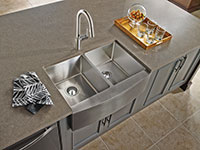Let's say you're doing a kitchen remodel. You're changing out cabinets, appliances, countertops and backsplashes. If ever there was a time to change the hardest working component of your kitchen, it is now. Farmhouse sink? Undermount sink? Drop-in sink? The options can seem endless. Here are some tips on different mounting styles, configurations, steel thickness and even some sink-centric bells and whistles.
Toni Sabatino is a certified Kitchen Designer (CKD), and the owner of Toni Sabatino Style, a design firm based in Long Island, New York. She uses a logical approach to thinking about how the sink fits into kitchen renovation projects. She says, “I start with the appliances and the sinks before I do any cabinetry patterns. Giant kitchens mean multiple sinks. Even if it's not a large kitchen I like using the biggest sink a kitchen will bear."
Types to Consider
 Sinks come in many sizes and three basic mounting styles. The simplest sink mount is known as a “drop-in" where the sink literally drops into a hole in the countertop. A rim around the sink holds it in place along with some waterproof adhesive. The economical drop-in can be used in countertops not made of a solid surface and is the easiest to install.
Sinks come in many sizes and three basic mounting styles. The simplest sink mount is known as a “drop-in" where the sink literally drops into a hole in the countertop. A rim around the sink holds it in place along with some waterproof adhesive. The economical drop-in can be used in countertops not made of a solid surface and is the easiest to install.
 The under mount sink is the opposite of the drop-in. In this case, a hole is cut in the countertop and the sink is installed under the counter with the lip secured against the bottom of the countertop. In order for it to work the countertop has to be made from stone, butcher block or some kind of material that leaves a clean edge when cut. Everybody loves the undermount, including Sabatino, “with an under mount, you can clean your countertops directly into the sink, it's a cleanliness factor," she says. “There's also the aesthetic, it looks a lot nicer."
The under mount sink is the opposite of the drop-in. In this case, a hole is cut in the countertop and the sink is installed under the counter with the lip secured against the bottom of the countertop. In order for it to work the countertop has to be made from stone, butcher block or some kind of material that leaves a clean edge when cut. Everybody loves the undermount, including Sabatino, “with an under mount, you can clean your countertops directly into the sink, it's a cleanliness factor," she says. “There's also the aesthetic, it looks a lot nicer."
 "Apron front" or “farm sinks" are very popular in kitchen designs that are more traditional and expose the front wall of the sink. Farm sinks are generally supported from below the countertop as opposed to being adhered to the countertop. They can be installed as under mounts, drop-ins or have their edges flush with the countertop.
"Apron front" or “farm sinks" are very popular in kitchen designs that are more traditional and expose the front wall of the sink. Farm sinks are generally supported from below the countertop as opposed to being adhered to the countertop. They can be installed as under mounts, drop-ins or have their edges flush with the countertop.
How Many Bowls Do You Need?
While you're figuring out your method of mounting, also consider how many bowls you want. Sabatino says, “for cooking enthusiasts a two bowl sink gives the home chef the ability to multi-task. You might want to consider a one-bowl for an entertainment sink in an area where space is a factor."
Selecting The Right Gauge
Assuming you're going with a stainless steel sink, it's also worth considering the gauge of metal used. The lower the gauge, the thicker the metal, the thicker the metal, the “quieter" the sink. If you're not going to have a garbage disposal hanging from the bottom of the sink or trying to save money, go with a thinner gauge. And speaking of noise, Moen sinks come standard with “SoundSHIELD," a sound deadening treatment that reduces vibration and noise caused by running water and clanging dishes.
So if you're contemplating a kitchen makeover do your homework and make smart decisions about your hard working and maybe under appreciated kitchen sink—you can't get much done without one.
